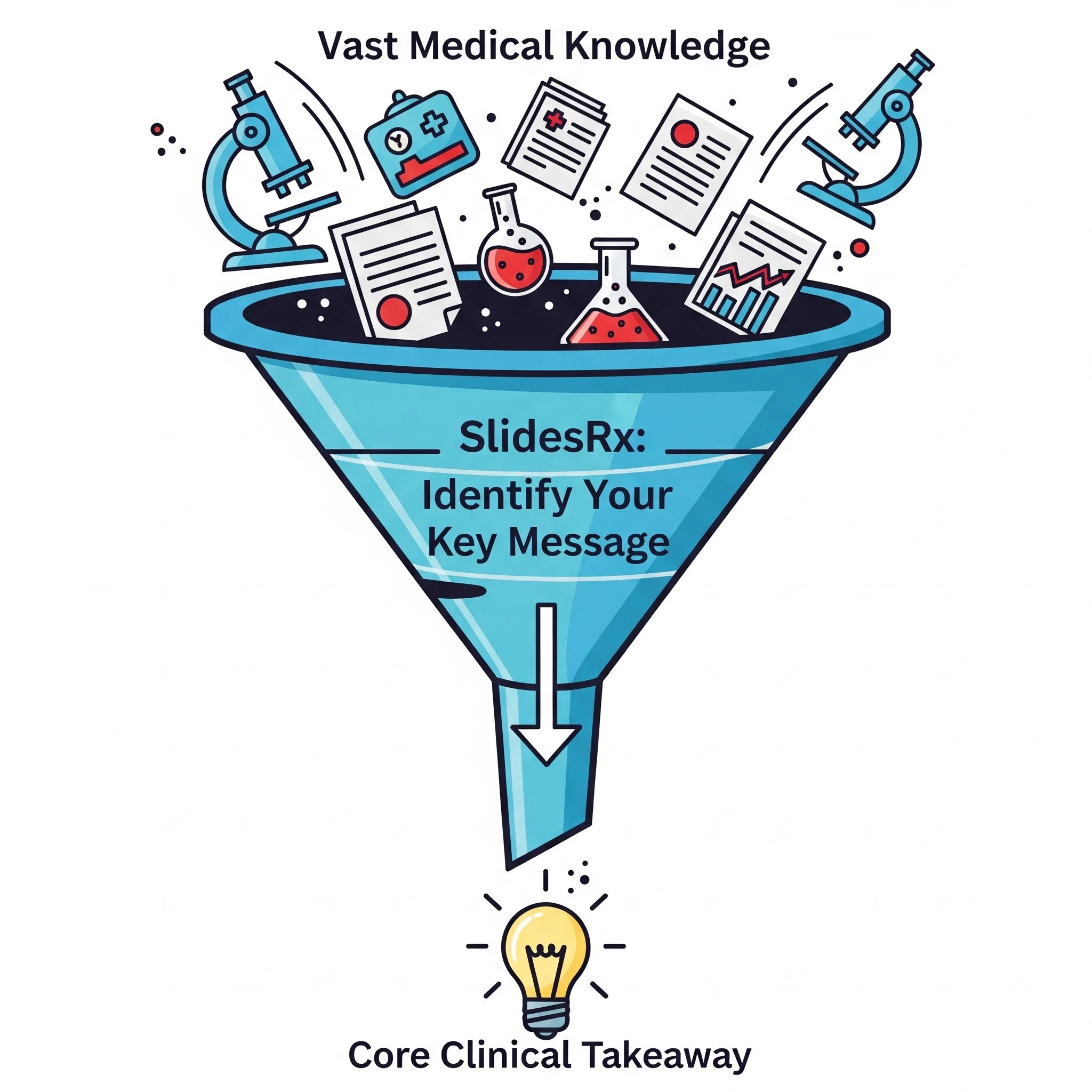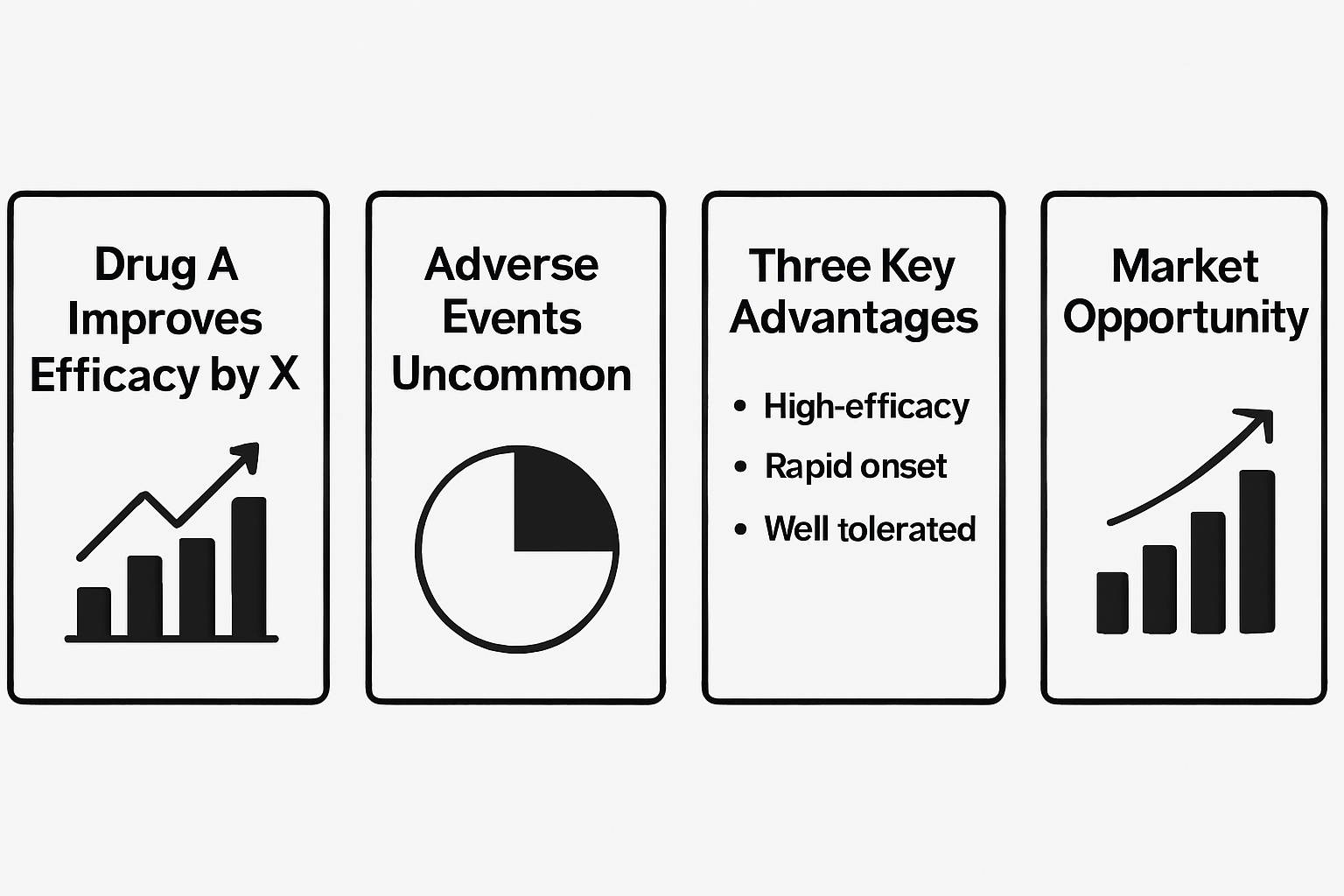One Message. One Impact.
The IMPACT of Clear Medical Presentations 🗣️
In the fast-paced world of medicine, every second counts. From grand rounds to patient education, the ability to communicate complex information clearly and confidently is paramount. At SlidesRx, we believe that clarity isn't just a desirable trait; it's a clinical imperative. This article, part of our "SlidesRx Checklist" series, will delve into the art and science of impactful medical presentations, focusing on how starting with one key message or clinical takeaway can elevate your communication, engage your audience, and ultimately improve patient outcomes.
Anchor Your Talk: The Power of a Single Message
In the vast sea of medical information, a presentation without a clear anchor is likely to drift, leaving your audience lost. Identifying and articulating a single, central message is the most critical first step. This approach ensures your audience grasps the most vital information, even if they remember nothing else.
Why One Message Rules Them All 🎯
Think of your most memorable lectures or clinical case presentations. Chances are, they weren't dense data dumps but rather sharply focused narratives built around a core idea. In medicine, where information overload is a constant threat, beginning your presentation with one clear clinical takeaway cuts through the noise. It tells your audience immediately what they should prioritize and remember. For example, if you're presenting on a new surgical technique, your single key message might be: "This minimally invasive approach significantly reduces patient recovery time." This immediate clarity is crucial for busy medical professionals, allowing them to quickly grasp the utility and relevance of your talk. It transforms a scattered set of facts into a cohesive, actionable insight.
Finding Your North Star: Identifying the Core Message 🧭
Before you even open PowerPoint, ask yourself: "If my audience remembers only one thing from this entire presentation, what would it be?" This question forces you to distill your content to its absolute essence. Is it a new diagnostic criterion? A critical safety protocol? A groundbreaking treatment outcome? This process, akin to a surgeon precisely identifying the core pathology, ensures your presentation is purpose-driven. It's about discerning the signal from the noise, providing a focused medical talk that respects your audience's time and attention. Without this foundational clarity, even the most meticulously researched data can fail to resonate.
Building Blocks: Structuring for Takeaway-Driven Impact
Once your core message is identified, every element of your presentation—from your introduction to your conclusion—should serve to reinforce it. This intentional structure ensures coherence and enhances retention.
Introduction as the Hook: Announce Your Message Early 🎣
Your introduction is more than just a greeting; it's your opportunity to immediately engage your audience and lay out your singular takeaway. State your main message clearly and concisely within the first minute. This isn't a spoiler; it's a guide. For instance, instead of a general introduction to "hypertension management," state: "Today, we'll demonstrate how integrating telehealth significantly improves hypertension control in rural patients." This proactive announcement creates a framework for your audience, helping them connect subsequent information back to your central point. An explicit presentation objective from the outset vastly improves audience comprehension and retention, preventing them from wondering, "Where is this going?"
Content as Reinforcement: Every Slide, One Point 💡
With your main message established, each subsequent slide should contribute directly to its support. This means embracing the "one message per slide" principle. Avoid cramming multiple ideas or excessive data onto a single visual. If you're discussing the benefits of a new medication, dedicate one slide to efficacy data, another to side effect profile, and a third to patient adherence rates—each with a clear, bold title reflecting its single point. This disciplined approach ensures that your content consistently builds toward your primary takeaway, making your clinical data presentation digestible and impactful. It's about guided discovery, leading your audience step-by-step toward your ultimate conclusion.
Making It Stick: Beyond the Podium
The impact of your single key message extends beyond the presentation itself. Strategic reiteration and a clear call to action ensure your takeaway has lasting clinical relevance.
Strategic Repetition: Reinforce, Don't Be Redundant 🔄
While "one message per slide" guides your content, reinforcing your core takeaway throughout the presentation is crucial for retention. This isn't about repeating yourself verbatim but rephrasing and re-contextualizing your main message. Mention it in your introduction, show data that supports it in your body, and re-emphasize it in your conclusion. A good strategy is to link each piece of supporting evidence back to your central theme. For example, after presenting efficacy data for a new vaccine, you might say, "This data directly supports our key message: the new vaccine significantly reduces hospitalization rates." This subtle yet consistent reinforcement ensures your memorable clinical presentation truly implants its core idea.
Call to Action: Translate Message into Impact 🚀
A clear key message should lead to a clear call to action. What do you want your audience to do with the information? Is it to adopt a new protocol, refer patients for a specific screening, or consider a different diagnostic approach? Your conclusion should tie your core message to a tangible next step. For example, if your key message was about improved hypertension control via telehealth, your call to action might be: "Implement a telehealth follow-up program in your clinic starting next quarter." This direct application of your concise medical takeaway transforms knowledge into practical impact, bridging the gap between presentation and patient care. It underscores the "why" behind your presentation, making the information clinically relevant.
Quick Takeaways:
Define Your Single Message: Before anything else, identify the one crucial takeaway.
Announce It Early: State your core message upfront in your introduction.
One Message Per Slide: Design each slide to convey a single, clear point.
Reinforce Strategically: Reiterate your main message throughout, linking it to your evidence.
Actionable Conclusion: End with a clear call to action tied directly to your key message.
Audience-Centric Focus: Always consider what your specific audience needs to remember.
Clarity Drives Impact: A focused message leads to better understanding and real-world application.
Conclusion: Precision in Every Point
In the demanding world of medical communication, clarity is not merely a virtue; it's a necessity. By embracing the discipline of starting with one key message or clinical takeaway and building your entire presentation around it, you ensure that your vital information is not just heard, but truly understood and retained. This methodical approach transforms complex medical data into actionable insights, empowering your audience to make informed decisions that benefit patient care. At SlidesRx, we specialize in helping medical professionals achieve this level of precision, because when lives are on the line, clarity isn't optional – it's clinical.
Next Week: Elevate Your Clarity - Use Bold, Specific Slide Titles (≤10 words).
Join us next week as we continue our journey through the SlidesRx Checklist by tackling the next crucial step: "Use Bold, Specific Slide Titles (≤10 words)." We'll explore how precise, impactful titles can immediately communicate your slide's single message, guiding your audience and enhancing overall comprehension. Get ready to transform your slide headers into powerful signposts!
We want to hear from you!
What's the most challenging aspect of distilling complex medical information into a single, clear takeaway for your presentations? Share your experiences and tips below – let's learn from each other! And if you found this article helpful, please share it with your colleagues.




